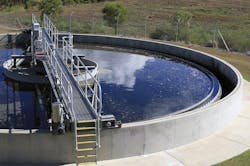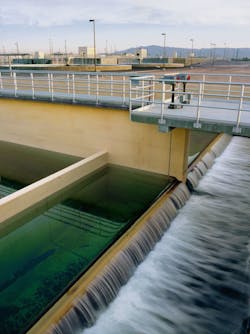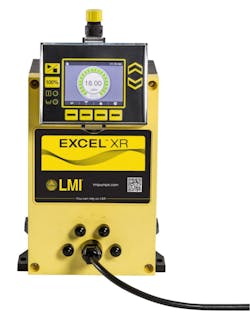The most precious resource on the planet — water — is something that people take for granted every day. The amount of water on Earth has essentially remained the same for billions of years. Although a tiny volume of hydrogen molecules occasionally evaporates into space, the overwhelming majority of the molecules mix with oxygen in the atmosphere and fall back to earth in a closed-loop cycle that features: evaporation, condensation, precipitation, infiltration and
surface runoff.
Water is increasingly in high demand because it is used more than ever before. As the planet’s population increases, consumption increases, but just over 1 percent of the water supply on earth can be used as drinking water.
Governments and private water companies must handle this precious commodity with the utmost care. They are responsible for providing safe, potable water; for safely treating wastewater; and for effectively managing stormwater while complying with regulatory requirements.
To accomplish these objectives, water treatment plants must maximize the efficiency, reliability and cost-effectiveness of their pumping infrastructures — specifically metering pumps — which play a critical role in the accurate delivery of the chemical additives necessary to treat water.
In water treatment applications, turndown is important because the volume and quality of the incoming water can vary on a regular basis.
New insight
To gain new insight, a metering pump manufacturer that has been in business for more than 80 years conducted an outreach campaign to users and distributors of its pumps used for municipal and industrial water treatment applications such as coagulation and flocculation; pH control; dechlorination; chemical precipitation and oxidation; ion exchange; chemical neutralization and stabilization; disinfection; and taste and odor control.
The goals of the program were twofold:
- To identify and understand customer needs and pain points and to rank and weigh the functionality that users wanted to see in metering pumps
- To share particular ideas with users and distributors to bring them into the development process as new pumps are designed and
manufactured
The majority of the feedback focused on leveraging technology to become more efficient and to reduce costs wherever possible. Pumping infrastructure can help achieve these objectives if it can deliver in the following areas:
Efficiency
Every water treatment application can benefit from efficiency gains from reduced power consumption and increased chemical dosing accuracy. The power bill and chemical costs represent the majority of water treatment plants’ operating expenses, so efficiency gains in these areas are noticeable.
The pumps used in water treatment applications should feature more efficient motors with variable speed drive technology that can handle a wide range of flows without being affected by discharge pressure changes. Pumps used in these applications should also provide 1,000-to-1 turndown capabilities, with +/- 1 percent steady state accuracy.
In water treatment applications, turndown is important because the volume and quality of the incoming water can vary regularly. Municipal treatment plants located on rivers need flexibility to deal with storms that bring mud and sediment, while those on large lakes with relatively small variations in turbidity may only require minimal dosage changes. Seasonal differences impact turndown capabilities because seasonal changes in water quality impact chemicals that lose concentration or effectiveness in higher temperatures.
Overtreating water is wasteful, expensive and does not produce a better product. But undertreating in processes such as drinking water disinfection could potentially harm consumers. Striking the right balance is critical, and this is directly related to the accuracy and the turndown capabilities of the metering pumps used for the process.
Reliability
For plants that run operations around the clock, reliability — specifically meantime between failures — for pumps is important. Although everyone would prefer an "install, start and forget" approach, the reality is that all types of pumps require basic maintenance to deliver specified performance. Typically, treatment facilities will select either (or both) mechanically actuated diaphragm pumps or peristaltic pumps for chemical injection.
The benefit of mechanically actuated diaphragm pumps is that they operate longer between maintenance actions than do peristaltic pumps and they have proven to be safer to operate.
Diaphragm pumps do not utilize polymer tubes or hoses that wear and fatigue from contact with drive rollers, which when weakened alter the flow characteristics and eventually fail without any
advance warning. Mechanically actuated diaphragm pumps have a more robust and time-proven design, providing longer life,
requiring less maintenance, maximizing plant uptime and minimizing the risks associated with leaks or spills that could result from failed hoses or tubing.
Pump intelligence starts with design. The control aspects in a metering pump should be able to control the process without relays or other control panels.
Intelligence & control
Pump intelligence starts with design. All the control aspects in a metering pump should be able to control the process without relays or other control panels. Pumps should be able to communicate with several digital and analog devices to manage various control schemes such as pulse input, timed events or batch processes. Remote connectivity should also be available to enable control and feedback in real time.
Flexibility is important because regulations can change each year as standards evolve and become more stringent. For example, what might have been considered an acceptable level of residual chlorine a decade ago is no longer acceptable. The acceptable ranges between what is considered overtreatment and undertreatment vary from country to country (and even from state to state). Often times, operating conditions and process requirements change after a plant has been built. As a result, pump equipment must be flexible enough to provide the control needed as requirements change.
Address vapor locking
One of the biggest issues water treatment plants must address is vapor locking. Bleaching chemicals such as sodium hypochlorite are prone to gasification when they become agitated. When a fluid gasifies, the pump can become gas-bound, causing the pump to stop. Diaphragm pumps address this problem by ensuring high fluid velocity through the pump head. Front-scavenging technology on the diaphragm evacuates the entire liquid end with every stroke, cleaning it out and evacuating the entire head so that air bubbles cannot accumulate and create vapor lock.
Because treatment plants run large-scale operations with high-duty cycles over long shifts, vapor locking is a problem that must be planned for and addressed to ensure plant uptime and the continuous and accurate distribution of chemicals.
Moving forward
As the demand for water increases, so too does the attention placed on water treatment plants. This added scrutiny and increased regulation comes at a time when many municipal budgets remain flat and in some cases are decreasing. To operate efficiently and cost-effectively, treatment plants must become more resourceful in their power and chemical use.
The good news is today’s newest generation of metering pumps is designed to provide greater reliability, intelligence and control — and this functionality delivers the efficiencies that municipalities demand for water treatment applications.
Jim Carling is the global product manager for Milton Roy municipal and industrial products. For the last 35 years, Carling has worked with Milton Roy’s municipal and industrial customers in many roles. He can be reached at [email protected].


